Progress Report
Hello! Astonishingly, the last time I posted about my In-Depth Project was in March and now it is April! Over spring break, I have had two more (the fifth and sixth) meetings with my mentor, both extraordinarily fruitful for both of us. To summarize my progress this past month, I have learned a great deal about the two sub-skills of maintaining brakes and maintaining the drivetrain on bikes. Read on to find out more about my experience with each!
Details of each sub-skill that I learned:
Adjusting/repairing brakes:
At our fifth meeting, my mentor and I delved in-depth into the topic of brakes. Here is video 1, video 2 and video 3 from the meeting.
Before the meeting, I had already had experience with brakes (we had even touched a bit on them in an earlier meeting), especially V-brakes, so this time we focused on Cantilever brakes. Essentially, I replaced a whole brake cable, which was an enjoyable and exciting first, and got lots of my questions answered.
Next, we discussed our next steps. To prepare for this meeting, I had read some of my bike maintenance books on the topic of Drivetrains, to plan what I wanted to learn about it as that was the next sub-skill on my list. So at the meeting, we finalized what I wanted to learn about the Drivetrain.
Drivetrain:
At the sixth meeting, I learned how to replace a gear cable and how to adjust a derailleur! This was another extraordinary, big, and long meeting because we covered so much. I do not have any videos of this meeting because my phone ran out of storage (see Obstacles/Frustrations). Either way, I first replaced the gear cable. Then, my younger cousin came because I had brought his bike to the meeting. The story behind this is that a few days before this sixth meeting, my cousin had said he had some problems with his brakes. I volunteered to see if I could help him out, as I had learned the sub-skill of brakes and this would be a great opportunity to see what I could do. It turned out his brake pads were extremely worn out, so I spent an afternoon going back and forth (because I forgot to bring money, etc. 😂) to Trek to buy brake pads, and then together, we replaced the brake pads on his bike! It was a good old exciting process, and he reported that the brakes were so much better. However, one out of four of the brake pads that we replaced did not cooperate. Here is a description of the issue:
So, this was something my cousin needed to be fixed so I offered to bring the bike to my mentor because I did not know what to do either. This brings us back to the meeting, where we spent a great time strengthening both my own and my cousin’s knowledge of brakes. It turned out the fix to the issue was brute force! We just needed to screw that brake pad tighter, which neither of us would have thought of as we are not as strong as David anyways. When I told my dad about this at home back from the meeting, he said that this is why it is difficult for one to learn a skill like this from, say, YouTube—one needs a mentor because the concept of needing to put more force into tightening it is not something that can be seen or taught on YouTube—a big shoutout to David! 😃
Other than replacing the gear cable and fixing up my cousin’s bike, we adjusted a rear derailleur. I will admit that for this sub-skill, my mentor thoroughly demonstrated to me (rather than me doing it/the coaching approach), because we were, sadly, short on time. Nevertheless, I learned how the low- and high-limit screws work, and David even showed us what it looks like to take the cassette off of a rear hub—it requires special tools and I had read about how to do this in the bike maintenance books, so it was awesome to see! If we had more time, we would have washed the whole cassette for better performance and more thorough maintenance before putting it back on, so that is something I have noted that we can do in a future meeting.
Afterwards, David sent me an email entailing all the steps of adjusting a rear and front derailleur. At home on my own time, I was able to use this to replace the gear cable and adjust the front derailleur of the bike! However, this also had a story to it because halfway through the steps, I had an issue: the derailleur wouldn’t move when I clicked the shifter. I messaged my mentor and with my perfect timing, he was at home and generously said I could bring the bike over and we could take a look together. We fixed the issue (I had threaded the cable incorrectly, and we did something cool to get it out—we took the whole shifter off the handlebar), but I think what I most importantly learned as David explained to me is that when an issue like this comes up, I need to diagnose the problem, like how a doctor diagnoses a patient. Just as the doctor asks the patient questions to gather information about their symptoms before diagnosing them, a mechanic must go, “This is the problem. What’s causing it? Is it this?” (at this point in our case, David pulled the cable to the front derailleur with his hand and that still moved the derailleur) “So the derailleur is still able to move, so it’s not that. Then it must be up here” (and that’s how we got to looking at the shifter up on the handlebar). When we looked at it, we realized the cable end was in the wrong place. “So then I said to myself, how could that have happened? Oh, I bet you, Anita didn’t have the shifter on the handlebar clicked into the proper position to properly line up the mechanism for the cable inside the shifter when she was installing the cable.” And sure enough, that was the cause of the issue. As I bolded above, the “Then it might/must be…” or “If it’s not this, let’s see if it’s that” is the crucial part of diagnosing a problem as a mechanic to fix the issue!
To report on my progress so far from a different angle, a major milestone has been achieved: one out of five of my bikes has been fixed from a condition of being non-rideable to being rideable right now! It is the Giant bike and throughout my posts, there have been lots of videos on it, although I regret never taking a video illustrating how the whole bike worked before (lesson learned, I shall do so right away for all the other bikes)
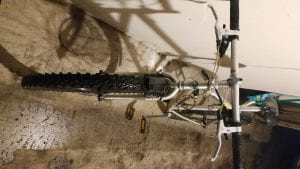
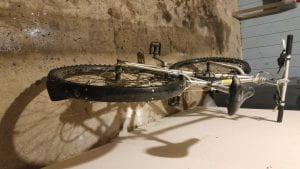
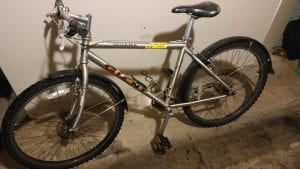
In these pictures of the bike from before, you may or may not be able to see the old cables. The gears, brakes, and tires of this bike have also been worked on and they are now in good working order:
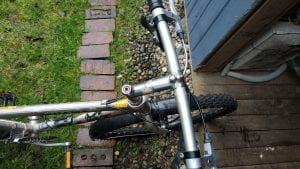
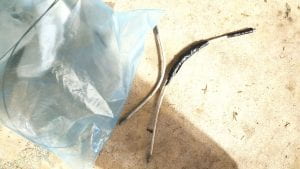
The replaced cables and the old cables.
Next steps/on my plate right now:
I have to finish doing work on brakes and gears to use and practice with my knowledge in the most up-to-date fashion. After I do this, my mentor and I are having our seventh meeting on April 10th, and the plan for that is to learn in-depth how to true a wheel. After that, we will go into cleaning/washing a bike.
Mentor
David is ever so facilitating for me and my project. I think we have grown much more comfortable with each other and have made a lot of progress. I now know in-depth how to maintain/repair brakes, gears, and more, compared to the beginning when I did not know basic bike maintenance yet.
Obstacles/Frustration
Putting the cable in the wrong hole for the front derailleur was an obstacle, but I quickly overcame it by messaging David and we had a casual get-together where we troubleshot it and I learned along the way. Another challenge is that right now, I am working on one of my bikes that I installed a basket on years ago. It is a bit frustrating because I want to keep the basket, but I need to arrange the shifters and brakes on the handlebar so it all fits and works smoothly. I still have not found a solution.
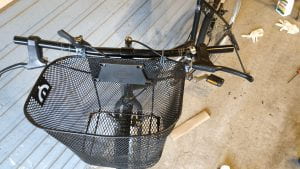
I think what I will do is I will research online attaching baskets to bikes. If that does not work, I will let go of my emotional attachment and just take it off. I might even be able to weave a basket and attach it properly later after I adjust the handlebar normally! One more challenge I would like to mention is that I had to upload all my bike maintenance videos to YouTube because the storage on my phone ran out. It ran out in the middle of filming our last meeting, so that was a bit of a bummer. I have learned now to try to upload videos to YouTube as soon as I have finished recording them, to keep my storage clear.
Posted Questions
1. What has been your most difficult mentoring challenge so far? Why?
A challenge David and I have is staying within our allotted meeting time. In the beginning, we planned for one-hour meetings but that was not enough time, so we planned for two-hour meetings. Even so, we sometimes go over time, into the three-hour range. For example, the day when my cousin came over to our meeting, David and I were there from 2 pm to about 5:30 pm! We both are okay with it and enjoy our meetings, albeit lengthy ones, and we always confirm with each other that we are fine with staying later when the original end time rolls around. A reason that this might be a challenge is that we might be too thorough. David tells me that he overexplains, which is not necessarily bad in our context because the project is called In-Depth after all.
2. What is working well? Why?
I think making an agenda for every meeting is working well. I always make an agenda by 6 pm the day before our scheduled meeting so we know what we want to cover. I bring my laptop to the meetings so I can take notes and check items off as we go. Sometimes David even prints out a copy too. I think having an agenda is working well because we have a clear idea of what is going on and it is also a great tool for me to log information/take notes both for further planning and notes on the skill I am learning, and to keep track of how our meeting is progressing.
3. What could be working better? How can you make sure this happens?
David is such a good teacher that sometimes he overexplains and it is a bit of a challenge for me to work up the courage to tell him so. He acknowledges that he overexplains, he says his wife says he does sometimes, and he says that if he does I can just cut in and say “I got it” or tell him to stop. But even so, it is still a challenge for me to communicate with him to stop. To make sure that we no longer spend extra time on explaining/understanding concepts, I can say with a smile, “I got it. Let’s move on so we can stay on track with time” because staying within our planned meeting time (two hours) is always a challenge for us!